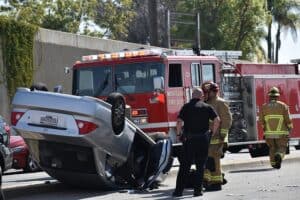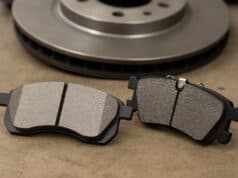TL;DR: Police reports rarely state fault directly. They document facts, witness statements, and officer observations, but insurance companies and courts make final fault determinations.

Police reports serve as crucial documentation after any car accident, but they don’t always provide the clear-cut answers victims expect. When dealing with the aftermath of a collision, many accident victims wonder whether the responding officer’s report will definitively establish who caused the crash. For comprehensive legal guidance on accident cases, contact Elsner Law Firm in Seattle for expert representation.
The reality is more complex than most drivers realize. While police accident reports contain valuable information about what happened at the accident scene, they rarely include direct statements about legal fault or financial responsibility.
What Information Does a Car Accident Police Report Contain?
A car accident police report serves as an official record of the incident. Law enforcement officers document specific details about the collision, creating a foundation for insurance claims and potential legal proceedings.
Police reports typically include:
- Date, time, and location of the accident
- Weather and road conditions at the scene
- Names and contact information of all drivers involved
- Insurance coverage details for each vehicle
- Witness statements from people who saw the accident occur
- Physical evidence like skid marks and vehicle damage
- Officer’s observations about the accident scene
- Traffic violations issued at the scene
The responding officer gathers this information by interviewing the parties involved, examining physical evidence, and taking photographs of vehicle damage. Most drivers provide their account of events, though injured drivers may be unable to speak immediately after the crash.
Officers document what they observe without making legal conclusions. They note facts like which vehicle struck which, where the collision occurred, and whether any traffic laws were violated. This documentation becomes part of the official accident report.
Road conditions play a major role in accident analysis. Officers document whether weather contributed to the crash, including rain, snow, ice, or fog that may have reduced visibility or traction. Construction zones present special challenges, as temporary traffic patterns and reduced speed limits create confusion for drivers unfamiliar with the area.
How Police Officers Determine Car Accident Fault at the Scene
Police officers don’t determine legal fault in the same way insurance companies or courts do. Instead, they assess whether any traffic violations occurred and document their observations about the accident.
Officers evaluate several factors:
- Whether drivers violated traffic laws (running red lights, speeding, failure to yield)
- Physical evidence at the accident scene
- Statements from all parties involved in the collision
- Witness accounts of what happened
- Road conditions and weather factors
- Vehicle positions after the crash
When clear traffic violations occur, officers may issue citations. For example, if one driver ran a red light and caused the accident, the officer will likely cite that driver for the violation. However, receiving a traffic citation doesn’t automatically make someone legally responsible for all damages.
The officer’s opinion about what happened gets included in the report, but this represents their professional assessment based on available evidence. Insurance adjusters and attorneys review these opinions when building their cases, but they don’t consider them final determinations of fault.
Traffic lane positioning matters significantly in fault determination. When vehicles cross center lines, drift into adjacent lanes, or fail to maintain proper spacing, these actions often indicate driver error or negligence. Officers measure skid marks to estimate vehicle speeds before impact, though this evidence may be compromised if other traffic disturbs the scene.
Car Accident Police Report Limitations in Determining Car Accident Fault
Police reports have significant limitations when it comes to establishing who caused a car accident. Understanding these constraints helps accident victims set realistic expectations about what the report will accomplish.
Key limitations include:
- Officers arrive after the accident happened, missing the actual collision
- Complex accidents may have multiple contributing factors
- Conflicting witness statements create uncertainty
- Some evidence may not be visible at the scene
- Officers lack complete information about driver behavior before the crash
Many car accidents involve disputed facts. When the other driver claims they had a green light while the injured party insists they did, the responding officer faces conflicting accounts. Without independent witnesses or traffic cameras, determining what actually occurred becomes challenging.
Physical evidence like vehicle damage provides clues, but it doesn’t always tell the complete story. A rear-end collision typically suggests the following driver was at fault, but exceptions exist. If the lead vehicle suddenly reversed or stopped without warning, fault may shift.
The green light versus red light dispute represents one of the most common conflicts in accident reporting. Without traffic cameras or independent witnesses, officers must rely on physical evidence and driver credibility to assess these claims. Intersection accidents often involve complex right-of-way issues that require detailed traffic law knowledge.
Accident Details That Affect Car Accident Scene Investigation
The specific circumstances surrounding how the accident occurred influence fault determination more than the police report alone. Insurance companies and legal professionals examine various factors when deciding who bears responsibility.
Critical accident details include:
- Speed of vehicles involved in the collision
- Whether drivers were distracted or impaired
- Mechanical failures that contributed to the crash
- Actions taken immediately before impact
- Traffic signals and signage at the location
State laws vary regarding fault determination. Some states follow modified comparative negligence rules, where fault can be shared between multiple parties. If one driver was speeding but the other ran a stop sign, both may bear partial responsibility for the accident.
The negligent driver isn’t always obvious from initial evidence. Insurance adjusters conduct thorough investigations, reviewing the police report alongside medical records, repair estimates, and additional witness statements. This comprehensive review often reveals details not captured in the initial police documentation.
Rear-ended collisions typically favor the front vehicle, but exceptions exist when the lead driver stops suddenly without justification or backs up unexpectedly. Following distance violations are common citations in these crashes, but other factors like mechanical brake failure or medical emergencies may shift responsibility.
How Insurance Companies Use Car Accident Reports
Insurance companies rely heavily on police accident reports when processing claims, but they don’t consider them the final word on fault determination. Adjusters use reports as starting points for their own investigations.
Insurance company review process:
- Obtain the official police report from law enforcement
- Interview all parties involved in the accident
- Examine vehicle damage and repair estimates
- Review medical records for injured parties
- Investigate the accident scene independently
- Consult with accident reconstruction experts when needed
The insurance adjuster assigned to the case makes the final fault determination for claim purposes. This decision affects how much each insurance policy pays for property damage, medical bills, and other losses resulting from the collision.
Insurance companies sometimes reach different conclusions than what the police report suggests. They have access to additional information and time to conduct thorough investigations. A crash that initially appeared straightforward may reveal complex contributing factors during detailed review.
Medical attention requirements affect officer investigations. When seriously injured parties need immediate transport to hospitals, officers may have limited time to interview them at the scene. Emergency responders prioritize life-saving care over evidence collection, sometimes disturbing the accident scene before complete documentation occurs.
When Police Reports Get Car Accident Fault Wrong
Police reports can contain errors or incomplete information that affects fault assessment. Officers work under time pressure at busy accident scenes, and mistakes do occur in their documentation.
Common police report errors:
- Incorrect driver or vehicle information
- Misrepresented witness statements
- Wrong assessment of traffic violations
- Incomplete documentation of road conditions
- Errors in describing the sequence of events
When parties involved believe the police report contains significant errors, they can request corrections through the law enforcement agency that filed the report. This process typically requires submitting additional evidence or documentation that supports the requested changes.
However, correcting police reports can be challenging. Officers may be reluctant to modify their original assessments, especially if substantial time has passed since the accident. Insurance companies and attorneys often work around report errors by presenting additional evidence that contradicts incorrect information.
The officer’s opinion about fault isn’t legally binding. Courts and insurance companies can reach different conclusions based on all available evidence, not just what appears in the police documentation.
Insurance policy details influence claim processing even when fault seems clear. No-fault policies in certain states limit the relevance of fault determination for medical expenses, though property damage claims still require fault assessment. Coverage limits affect settlement negotiations regardless of who caused the accident.
Steps to Take After the Accident Happened
Proper actions at the accident scene help ensure accurate police reporting and protect legal rights. Knowing what to do immediately after a collision can influence how fault gets determined later.
Essential steps at the accident scene:
- Call 911 to report the accident and request police response
- Check for injuries and provide first aid if qualified
- Move vehicles out of traffic lanes when safely possible
- Document the scene with photographs before vehicles are moved
- Exchange insurance and contact information with other drivers
- Identify witnesses and obtain their contact details
- Avoid admitting fault or speculating about what caused the crash
Passengers in vehicles involved should also provide statements if they witnessed relevant details. Their accounts may offer different perspectives than the drivers, who were focused on operating their vehicles.
Gathering evidence at the scene helps support accurate reporting. Photographs of vehicle positions, traffic signals, road conditions, and damage provide valuable documentation that supplements the police report.
Financial responsibility laws vary by state but generally require drivers to carry minimum insurance coverage or post bonds to pay for accident damages. Uninsured drivers face additional penalties beyond fault determination, including license suspension and vehicle impounding in many jurisdictions.
How Courts Determine Fault Through Legal Proceedings
When insurance companies can’t agree on fault or when significant injuries occur, legal proceedings may be necessary to establish who was responsible for the car accident.
Personal injury lawsuits allow injured parties to present evidence about what caused the accident. Courts examine all available evidence, including police reports, expert testimony, and witness statements, to determine liability.
Legal fault determination considers:
- Traffic law violations by drivers involved
- Whether reasonable care was exercised by each party
- Comparative negligence principles in the jurisdiction
- Evidence of impairment, distraction, or reckless driving
- Road design or maintenance issues that contributed to the crash
Judges and juries make final determinations about fault in contested cases. Their decisions can differ from police assessments or insurance company conclusions, particularly when new evidence emerges during legal discovery.
The burden of proof in civil cases requires showing fault by a preponderance of evidence. This standard is lower than criminal cases, making it possible to establish civil liability even when criminal charges weren’t filed.
Present evidence requirements in court proceedings exceed police report documentation. Attorneys gather expert witness testimony, accident reconstruction analysis, and medical records to build comprehensive cases. The court process allows for discovery of information not available during initial police investigations.
State laws governing fault determination differ significantly across jurisdictions. Some states apply pure comparative negligence, allowing recovery even when plaintiffs bear majority fault. Others use modified comparative negligence with 50% or 51% thresholds that bar recovery for primarily responsible parties.
Most drivers lack understanding of their legal rights after accidents. Speaking with insurance adjusters without legal representation can harm claims, as adjusters work to minimize their company’s payouts. Attorney consultation provides protection against tactics designed to reduce compensation for legitimate claims.
Speed limit violations appear in many accident reports, but proving speeding without radar measurements can be challenging. Officers estimate speeds based on damage patterns and witness accounts, but these assessments may lack precision needed for court proceedings.
Vehicle inspections at accident scenes reveal mechanical defects that contributed to crashes. Brake failures, steering problems, and tire blowouts can shift fault away from driver error toward maintenance negligence or product defects. These discoveries often require follow-up investigations by specialists.
FAQ Section
Does the police report say who is at fault?
Police reports rarely state fault directly. Officers document facts, violations, and observations, but legal fault determination happens through insurance investigations or court proceedings.
How do you prove it’s not your fault?
Gather evidence like photographs, witness statements, and traffic camera footage. Challenge inaccurate police report details and provide documentation supporting your version of events.
How is fault determined in South Carolina?
South Carolina follows modified comparative negligence rules. Fault can be shared between parties, but recovery is barred if you’re more than 50% responsible for the accident.
What does a police accident report show?
Reports show accident location, time, weather conditions, driver information, witness statements, officer observations, traffic citations issued, and basic facts about vehicle damage.
Does a police report determine fault?
No, police reports document facts but don’t make legal fault determinations. Insurance companies and courts decide liability based on all available evidence.
What if a police accident report is wrong?
Contact the reporting agency to request corrections. Provide evidence supporting changes needed. Insurance companies can also consider additional evidence beyond the report.
How is fault determined in a car accident in Texas?
Texas uses modified comparative negligence with a 51% rule. You can recover damages unless you’re more than 50% at fault for the accident.
Who determines who is at fault during an accident?
Insurance adjusters make fault determinations for claim purposes. In disputed cases, courts make final liability decisions through legal proceedings with full evidence review.
How do insurance companies prove who is at fault?
Insurers investigate by reviewing police reports, interviewing parties and witnesses, examining vehicle damage, consulting experts, and analyzing all available evidence comprehensively.
How long does an insurance company have to determine fault?
Time limits vary by state and policy terms. Most insurers complete fault determinations within 30-60 days of receiving all necessary documentation and evidence.
Is it better to admit fault in a car accident?
Never admit fault at the scene. Let investigators review all evidence objectively. Admitting fault can hurt your case even if you weren’t actually responsible.
Do you need a police report to file an insurance claim in DE?
Delaware doesn’t require police reports for all insurance claims, but reports help support claims and provide official documentation of the accident details.
Is there a difference between an accident report and a police report?
Police reports are official law enforcement documents. Accident reports may refer to insurance company forms or other documentation related to the collision.
When someone hits you, do you call your insurance or theirs?
Call your insurance company first to report the claim. They’ll coordinate with the other driver’s insurer and protect your interests throughout the process.
What are accident codes?
Accident codes are standardized numbers police use to classify collision types, contributing factors, and circumstances. They help organize accident data for statistical analysis.
How to read codes on a police report?
Contact the issuing police department for code explanations. Many departments provide code sheets or guides that explain what each number or abbreviation means.
Does a crash report say who was at fault?
Crash reports document facts and violations but rarely assign legal fault directly. They provide information used by others to determine responsibility.
How do you know whose fault it is in an accident?
Fault determination requires analyzing evidence, traffic laws, witness statements, and expert opinions. Insurance adjusters and courts make these assessments based on available proof.
Do police officers determine fault in an accident?
Officers document violations and observations but don’t make legal fault determinations. They assess traffic law compliance and provide professional opinions about circumstances.
How much are most car accident settlements?
Settlement amounts vary widely based on injuries, damages, and fault percentages. Minor accidents may settle for thousands while serious injuries can result in six-figure settlements.
What qualifies as an at-fault accident?
At-fault accidents occur when a driver’s negligent or illegal actions cause the collision. Examples include running red lights, speeding, or following too closely.
Understanding police report limitations helps accident victims take appropriate steps to protect their rights and obtain fair compensation. While reports provide valuable documentation, they represent just one piece of evidence in fault determination. Successful accident claims require comprehensive evidence gathering, proper legal representation, and thorough investigation of all circumstances surrounding the collision. Don’t rely solely on police reports to establish fault – work with experienced professionals who understand how to build strong cases that accurately reflect what happened and who bears responsibility for the damages that resulted.





